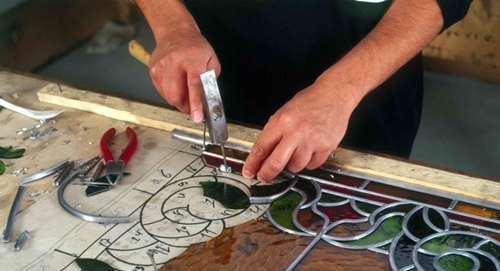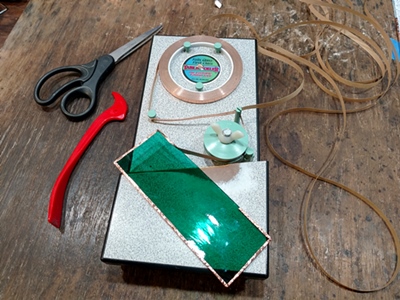
There are two basic types of construction of stained glass pieces: The copper foil method (also known as the “Tiffany” method), and the lead channel came method.
The traditional method of surrounding glass pieces with lead channel came and soldering the joints together was first written about in the late 11th century. It was the method used for constructing large church windows and is still in use today. It is best suited for designs with larger and simpler shapes. The detail you see on many church windows is actually painted onto the glass.
This picture shows an artist wrapping the glass in lead came. 
The copper foil method was made famous by Louis Comfort Tiffany in the early 1900’s, when he acquired the patent from Stanford Bray for his copper foil technique of constructing stained glass pieces. The copper foil technique involves wrapping each piece of glass in a copper foil tape, and then soldering them together. Louis Comfort used this technique in constructing elaborate stained glass lamps and windows, as it allowed for a much greater level of detail than the traditional lead channel came method.
Here is a picture of my "high tech" foiling machine. It's rudimentary, but is much quicker than doing it completely by hand!

Each method has its pros and cons.
The lead lines are more uniform in lead channel came construction. But because lead is a soft metal that can stretch, the glass can become loose and rattle or fall out over time. However, it can hold up better in outdoor environments than copper foil. Proper puttying around the lead channel can also help keep the glass more secure. This method does not work well for detailed design, but it is more forgiving when glass pieces are not cut perfectly because the lead channel came hides small imperfections.
It is harder to achieve uniform lead lines in copper foil due to the varying thicknesses of glass used and the skill needed to wrap evenly. But the variations can also add interest to a piece and are often intentionally varied as part of the overall design. Copper foil will hold more securely than lead came construction over time if kept in a dry environment. But if exposed to the outdoor elements, the adhesive on the copper tape can fail and cause the piece to come apart. Copper foil works well for both detailed, and simpler designs. It does require more precision glass cutting/shaping than lead came construction for best results.
Of course, the durability of either type of construction is largely based on the expertise of the person constructing it. Poor workmanship in either technique will result in a weaker and less attractive piece.
I only use the copper foil method for my pieces, as I enjoy the versatility it provides. It allows me to use a wider variety of shapes in my designs for more realistic detail. I do use zinc channel framing (which is harder than lead) for the outside borders of rectangular panels to provide a sturdy structure.
